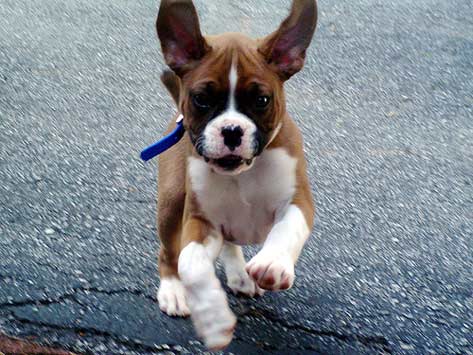How Much Exercise is Too Much for My Puppy?
I actually get variations of this question a lot (it was even the first question I got on Purely Puppy). When can I jog with my puppy? How far can my puppy walk/jog? When can I start agility training for my puppy?
I usually stumble through some kind of vague answer involving letting the puppy set the pace and not overdoing it. Turns out, after a search of VIN (Veterinary Information Network), many vets do exactly what I do.
Several vets say they "waffle" an answer; one said she "wings an answer." That technique isn’t taught in vet school. You reach a point where you take all the info that you can gather from your brain and present it to the client and hope against hope that it bears some relevancy to their question.
My search yielded cold hard answers, though. (I told you I would learn through this blog too!) Incidentally, the question was even in the "Medical FAQ" section of VIN's website, so I’m definitely not the only one asking.
Anyhow, the VIN consultants (a consortium of boarded veterinary specialists) point out that there is no "hard and fast" answer. However, there is evidence to support that there is an increase in the severity and incidence of elbow dysplasia and OCD in dogs who experienced "forced exercise" before their growth plates closed. Note that OCD is not obsessive compulsive disorder! Clients usually look shocked and laugh uncomfortably when joint OCD, which stands for Osteochondritis Dessicans, comes up. OCD is basically growth abnormalities in the cartilage that can cause lameness.
Forced exercise is defined as "anything beyond what the dog would engage in with dogs of the same age." Gentle play time with other like aged puppies? A-OK. Running around with adult dogs, meanwhile, is bad (the puppy will overdo it trying to keep up with the big guys). Fence-running, excessive ball/stick/Frisbee chasing, and jogging with the owner are considered "forced exercise," too. (Does the concept of doggie "forced exercise" bring to mind little army puppies in camo gear doing forced "boot camp" runs with little rifles over their heads, or is it just me?)
When it comes to agility training, Joni L. Freshman, veterinarian and agility expert, says she doesn’t start "any jumping training, any weave poles or any contact (climbing) obstacles until the growth plates are closed as well."
In large breed dogs, the growth plates close generally around 12 months of age. The recommendation, according to VIN's Medical FAQ Exercising Puppies, is "waiting until these dogs are 12-15 months old [will] allow the owner to enjoy many more years of exercising with their pets by allowing adequate skeletal development."
So there’s the scoop. No more waffling, winging or stumbling for me on this issue.

Dr. Vivian Carroll
Pic of the day: Wind Sprint by B Rosen

